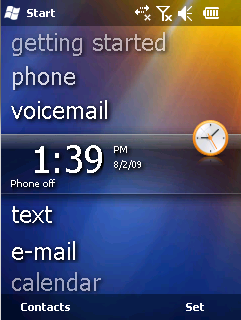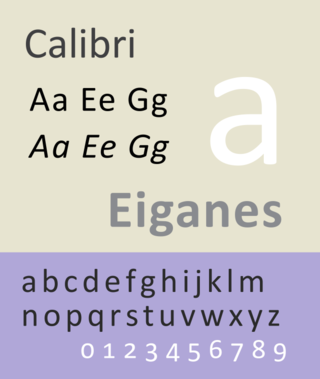
AbiWord is a free and open-source word processor. It is written in C++ and since version 3 it is based on GTK+ 3. The name "AbiWord" is derived from the root of the Spanish word "abierto", meaning "open".

Microsoft Word is a word processor developed by Microsoft. It was first released on October 25, 1983, under the name Multi-Tool Word for Xenix systems. Subsequent versions were later written for several other platforms including: IBM PCs running DOS (1983), Apple Macintosh running the Classic Mac OS (1985), AT&T UNIX PC (1985), Atari ST (1988), OS/2 (1989), Microsoft Windows (1989), SCO Unix (1990), macOS (2001), Web browsers (2010), iOS (2014) and Android (2015). Using Wine, versions of Microsoft Word before 2013 can be run on Linux.

Microsoft Office, or simply Office, is a family of client software, server software, and services developed by Microsoft. It was first announced by Bill Gates on August 1, 1988, at COMDEX in Las Vegas. Initially a marketing term for an office suite, the first version of Office contained Microsoft Word, Microsoft Excel, and Microsoft PowerPoint. Over the years, Office applications have grown substantially closer with shared features such as a common spell checker, Object Linking and Embedding data integration and Visual Basic for Applications scripting language. Microsoft also positions Office as a development platform for line-of-business software under the Office Business Applications brand.
QuickTime is a discontinued extensible multimedia architecture created by Apple, which supports playing, streaming, encoding, and transcoding a variety of digital media formats. The term QuickTime also refers to the QuickTime Player front-end media player application, which is built-into macOS, and was formerly available for Windows.

Microsoft PowerPoint is a presentation program, created by Robert Gaskins and Dennis Austin at a software company named Forethought, Inc. It was released on April 20, 1987, initially for Macintosh computers only. Microsoft acquired PowerPoint for about $14 million three months after it appeared. This was Microsoft's first significant acquisition, and Microsoft set up a new business unit for PowerPoint in Silicon Valley where Forethought had been located.
Windows Media Video (WMV) is a series of video codecs and their corresponding video coding formats developed by Microsoft. It is part of the Windows Media framework. WMV consists of three distinct codecs: The original video compression technology known as WMV, was originally designed for Internet streaming applications, as a competitor to RealVideo. The other compression technologies, WMV Screen and WMV Image, cater for specialized content. After standardization by the Society of Motion Picture and Television Engineers (SMPTE), WMV version 9 was adapted for physical-delivery formats such as HD DVD and Blu-ray Disc and became known as VC-1. Microsoft also developed a digital container format called Advanced Systems Format to store video encoded by Windows Media Video.
The Open Document Format for Office Applications (ODF), also known as OpenDocument, standardized as ISO 26300, is an open file format for word processing documents, spreadsheets, presentations and graphics and using ZIP-compressed XML files. It was developed with the aim of providing an open, XML-based file format specification for office applications.

Windows Mobile is a discontinued mobile operating system developed by Microsoft for smartphones and personal digital assistants.

TextMaker is a word processor, which aims at utmost compatibility with Microsoft Word, its default document format is .docx.
The following tables compare general and technical information for a number of office suites:

Calibri is a digital sans-serif typeface family in the humanist or modern style. It was designed by Luc(as) de Groot and released to the general public, with Microsoft Office 2007 and Windows Vista. In Office 2007, it replaced Times New Roman as the default typeface in Word and replaced Arial as the default in PowerPoint, Excel, Outlook, and WordPad. De Groot described its subtly rounded design as having "a warm and soft character". In January 2024, the font was replaced by Microsoft's new bespoke font, Aptos, as the new default Microsoft Office font, after 17 years.

Skype for Business is an enterprise software application for instant messaging and videotelephony developed by Microsoft as part of the Microsoft 365 suite. It is designed for use with the on-premises Skype for Business Server software, and a software as a service version offered as part of 365. It supports text, audio, and video chat, and integrates with Microsoft 365 components such as Exchange and SharePoint.
This is a comparison of word processing software.
SoftMaker Office is an office suite which aims for compatibility with Microsoft Office. It is available as a one-time purchase, as well as a subscription. A freeware version with a slightly reduced feature set is released under the name SoftMaker FreeOffice.
Spreadsheet is a class of application software design to analyze tabular data called "worksheets". A collection of worksheets is called a "workbook". Online spreadsheets do not depend on a particular operating system but require a standards-compliant web browser instead. One of the incentives for the creation of online spreadsheets was offering worksheet sharing and public sharing or workbooks as part of their features which enables collaboration between multiple users. Some on-line spreadsheets provide remote data update, allowing data values to be extracted from other users' spreadsheets even though they may be inactive at the time.
Midori was the code name for a managed code operating system (OS) being developed by Microsoft with joint effort of Microsoft Research. It had been reported to be a possible commercial implementation of the OS Singularity, a research project begun in 2003 to build a highly dependable OS in which the kernel, device drivers, and application software are all written in managed code. It was designed for concurrency, and could run a program spread across multiple nodes at once. It also featured a security model that sandboxes applications for increased security. Microsoft had mapped out several possible migration paths from Windows to Midori. Midori was discontinued some time in 2015, though many of its concepts were used in other Microsoft projects.

PlanMaker is a spreadsheet program that is part of the SoftMaker Office suite. It is available on Microsoft Windows, MacOS, Linux and Android and iOS.

MSN Messenger, later rebranded as Windows Live Messenger, was a cross-platform instant-messaging client developed by Microsoft. It connected to the now-discontinued Microsoft Messenger service and, in later versions, was compatible with Yahoo! Messenger and Facebook Messenger. The service was discontinued in 2013 and was replaced by Skype.









